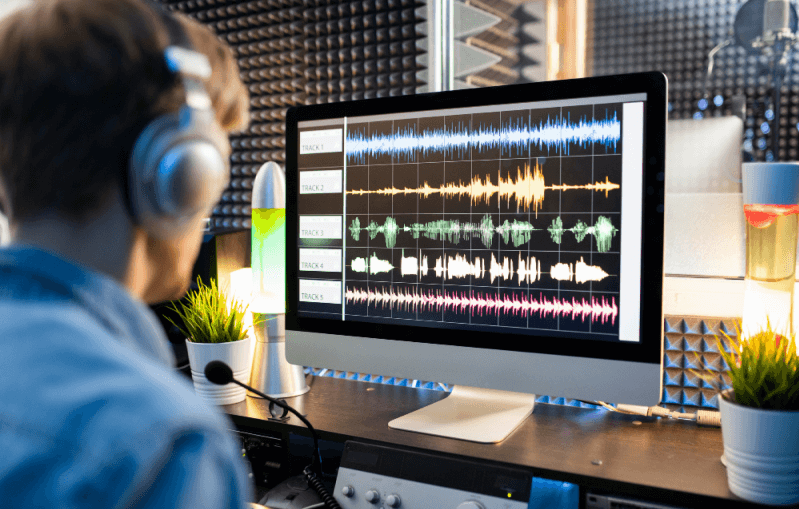Comprehending the Incorporation of Audio Visual Innovation in Today's Educational Environments
The integration of audio-visual innovation in academic settings has transformed the mentor and learning process. Educators currently have accessibility to tools that provide to various discovering styles, improving trainee engagement and collaboration. The consolidation of these modern technologies presents both chances and difficulties. Recognizing just how to effectively implement these devices is important. What methods can teachers utilize to maximize the advantages of audio-visual modern technology in their class?
The Advancement of Audio-Visual Modern Technology in Education
As academic requirements developed over the decades, audio-visual technology went through substantial makeovers that reshaped the knowing setting. Devices such as movie projectors and slide programs were the main means of integrating visual components right into classrooms. These early technologies provided educators with the capacity to existing information dynamically, yet they were restricted in ease of access and interactivity.
With the introduction of video clip cassette recorders in the 1970s, class began to include taped lessons, widening the range of educational resources. The intro of personal computers in the 1980s more reinvented this landscape, enabling the development of multimedia discussions and interactive knowing experiences.
The rise of the web in the 1990s noted a zero hour, making it possible for real-time accessibility to a wide range of audio-visual materials. Today, digital tools such as interactive whiteboards and online knowing systems remain to enhance the academic experience, fostering involvement and partnership among students.
Advantages of Audio-Visual Tools for Diverse Discovering Styles
Audio-visual devices play an important function in dealing with diverse discovering designs by boosting aesthetic understanding and boosting auditory involvement. By including photos, video clips, and audio, these innovations create a more inclusive instructional setting. This multifaceted technique permits instructors to deal with the different choices and demands of pupils successfully.
Enhancing Visual Discovering
Involvement in the discovering procedure is substantially improved with using audio-visual tools, dealing with different finding out designs. These devices, such as videos, infographics, and interactive discussions, give visual stimulations that aid comprehension and retention. Aesthetic students, in particular, take advantage of the unification of photos and computer animations, which can simplify complicated concepts and boost understanding. In addition, audio-visual sources can highlight real-world applications, making learning a lot more pertinent and appealing. By integrating shade, motion, and audio, educators can develop a dynamic learning atmosphere that records trainees' attention and promotes much deeper cognitive links. Inevitably, the strategic use audio-visual technology not only sustains visual understanding but additionally enriches the general educational experience for varied learners.
Improving Auditory Engagement
A significant advantage of incorporating audio-visual tools in education and learning is their capability to boost auditory involvement among students. These devices, which include multimedia presentations, podcasts, and interactive audio components, deal with various learning designs, especially profiting auditory learners (audio visual charlotte nc). By incorporating audio and narration, educators can create immersive experiences that capture students' interest and enhance understanding. This involvement is necessary, as it fosters a much deeper understanding of the material and promotes retention. Additionally, audio-visual devices can facilitate collective knowing settings, motivating pupils to take part in discussions and share their understandings. Ultimately, the consolidation of audio-visual innovation not only supports acoustic engagement yet additionally enriches the overall academic experience, making discovering more dynamic and efficient for all students
Enhancing Engagement Via Interactive Understanding

Gamification components, such as quizzes and simulations, can boost inspiration and retention, making finding out much more delightful and efficient. These techniques not just stimulate cognitive interaction yet likewise provide to diverse knowing designs, making certain that all students can take part meaningfully. As an outcome, interactive discovering environments promote a feeling of neighborhood and belonging, inevitably bring about improved scholastic end results. Through the integration of audio visual technology, educators can transform conventional classrooms into dynamic rooms where pupils prosper and actively shape their academic journeys.
Linking Concept and Experiment Multimedia Resources
Multimedia resources serve as an important link between academic ideas and useful application in educational setups. By enhancing interaction, facilitating collaborative understanding experiences, and supporting diverse knowing styles, these tools produce a much more comprehensive and dynamic knowing atmosphere - audio visual charlotte nc. This method not only cultivates deeper understanding however also prepares trainees for real-world challenges

Enhancing Involvement Via Multimedia
Engagement in academic setups substantially raises when instructors incorporate multimedia sources right into their mentor techniques. Making use of video clips, podcasts, and interactive presentations boosts the finding out experience, enabling students to get in touch with the product on several degrees. Multimedia resources provide to different discovering designs, supplying aesthetic, acoustic, and kinesthetic stimulations that can hold trainees' attention better than conventional lecture approaches. Additionally, these sources can streamline complicated concepts, making them extra easily accessible and remarkable. By integrating multimedia, instructors can develop a dynamic class environment that cultivates inquisitiveness and encourages learners. Inevitably, the tactical use of audio-visual technology offers to link the space between theoretical expertise and useful application, enhancing the academic experience for both trainers and trainees.
Promoting Collaborative Discovering Knowledge
Many studies indicate that collaborative knowing experiences significantly enhance pupil outcomes when integrated with multimedia resources. Multimedia devices help with interaction among students, allowing them to participate in problem-solving and vital assuming jointly. By using video clip conferencing, collaborative platforms, and interactive discussions, educators develop environments for synergy and shared discovering. These innovations allow pupils to connect their concepts efficiently and receive prompt responses, cultivating a deeper understanding of the topic. On top of that, multimedia sources can provide complex concepts in more absorbable formats, advertising discussion and partnership. As a result, the combination of collective understanding and audio-visual technology not only improves the educational experience but additionally prepares students for real-world teamwork characteristics, highlighting the importance of cooperation and collective understanding construction.
Supporting Diverse Learning Styles
While typical training techniques often satisfy a restricted variety of learning preferences, the integration of audio-visual innovation uses a more comprehensive technique to education. By utilizing multimedia sources such as videos, interactive simulations, and digital presentations, educators can deal with various discovering more info styles, including visual, acoustic, and kinesthetic. This versatility permits for differentiated instruction, enabling students to engage with content in ways that resonate with their private preferences. Additionally, audio-visual devices can promote much deeper understanding by providing several depictions of complicated principles. Therefore, trainees that might deal with standard methods can find alternate paths to success, fostering a much more fair knowing setting that supports scholastic success for all learners.
Obstacles in Executing Audio-Visual Modern Technology
Although audio-visual innovation holds fantastic guarantee for improving academic experiences, its application typically runs into substantial obstacles. One main concern is the monetary concern connected with acquiring and maintaining such tools, which can stress budgets, especially in underfunded organizations. In addition, insufficient training for instructors can hinder effective integration, leaving them ill-prepared to make use of the modern technology fully. Technical problems, such as software program breakdowns and compatibility issues, may likewise interrupt lessons and discourage both educators and trainees. Differing levels of trainee access to technology outside the class can create variations in discovering opportunities. Ultimately, the potential for over-reliance on innovation might interfere with crucial training techniques, ultimately restricting the academic experience. Dealing with these difficulties calls for a comprehensive strategy, consisting of ample funding, expert development, and equitable access to resources, to ensure that audio-visual technology can be leveraged properly in today's instructional settings.
Best Practices for Integrating Modern Technology in the Classroom

Furthermore, fostering an interactive atmosphere via joint tools encourages pupil interaction and involvement. Utilizing varied audio-visual sources accommodates different learning designs, suiting visual, auditory, and kinesthetic students. Frequently reviewing the effect of modern technology on pupil knowing aids educators refine their approaches and adapt to transforming demands. Including trainees in the selection of technology advertises ownership and motivation. By sticking to these best methods, teachers can create a dynamic classroom atmosphere that efficiently incorporates modern technology and boosts the instructional experience for all pupils.
The Future of Audio-Visual Modern Technology in Education
As class progressively welcome technology, the landscape of audio-visual tools in education and learning remains to evolve (audio visual charlotte nc). Future innovations are anticipated to concentrate on greater interactivity and personalization, permitting educators to customize finding out experiences to private trainee requirements. Developments such as augmented reality (AR) and virtual fact (VR) will likely provide immersive discovering atmospheres, boosting student engagement and understanding
Man-made intelligence (AI) is positioned to play a substantial function in audio-visual technology by providing real-time comments and adaptive learning pathways. This combination may help instructors recognize and address student obstacles better. Cloud-based systems will certainly help with much easier access to resources and partnership amongst pupils and educators, no matter area.
Along with these technical breakthroughs, expert growth for teachers will be essential, guaranteeing they are equipped to use these tools successfully. On the whole, the future of audio-visual modern technology in education and learning guarantees to create more vibrant, inclusive, and impactful discovering experiences.
Often Asked Concerns
Exactly How Can Teachers Choose the Right Audio-Visual Equipment for Their Classrooms?
Picking appropriate audio-visual devices requires teachers to analyze their instructional objectives, take into consideration trainee needs, evaluate readily available innovation, and look for suggestions from peers or professionals, making certain tools effectively improve knowing and interaction within their specific class environment.
What Budget plan Factors to consider Are There for Carrying Out Audio-Visual Technology?
Budget considerations for applying audio-visual technology consist of preliminary acquisition costs, maintenance costs, training for staff, and prospective software program licensing costs. Additionally, long-lasting investment in updates and substitutes must also be factored right into monetary planning.
Exist Specific Training Resources for Educators on Audio-Visual Equipment?
Lots of establishments provide training sources for educators on audio-visual devices, including on-line programs, workshops, and educational guides. These resources intend to enhance instructors' skills and self-confidence in effectively integrating technology into their mentor practices.
How Do We Determine the Efficiency of Audio-Visual Technology in Knowing?
Measuring the effectiveness of audio-visual modern technology in discovering entails examining trainee involvement, comprehension, retention rates, and overall academic efficiency. Studies, assessments, and observational researches can give beneficial understandings right into its effect on instructional outcomes.
What Prevail Misconceptions Concerning Audio-Visual Technology in Education?
Usual misunderstandings about audio-visual technology in education and learning include the idea that it guarantees interaction and learning outcomes, along with the presumption that all trainees profit equally, ignoring specific discovering preferences and requirements.